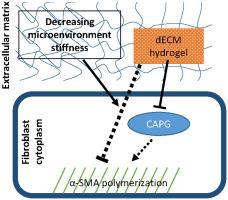Journal of Molecular and Cellular Cardiology ( IF 5 ) Pub Date : 2021-06-10 , DOI: 10.1016/j.yjmcc.2021.06.001 Xinming Wang 1 , Valinteshley Pierre 1 , Chao Liu 1 , Subhadip Senapati 2 , Paul S-H Park 2 , Samuel E Senyo 1

|
Controlling fibrosis is an essential part of regenerating the post-ischemic heart. In the post-ischemic heart, fibroblasts differentiate to myofibroblasts that produce collagen-rich matrix to physically stabilize the infarct area. Infarct models in adult mice result in permanent scarring unlike newborn animals which fully regenerate. Decellularized extracellular matrix (dECM) hydrogels derived from early-aged hearts have been shown to be a transplantable therapy that preserves heart function and stimulates cardiomyocyte proliferation and vascularization. In this study, we investigate the anti-fibrotic effects of injectable dECM hydrogels in a cardiac explant model in the context of age-associated tissue compliance. Treatments with adult and fetal dECM hydrogels were tested for molecular effects on cardiac fibroblast activation and fibrosis. Altered sensitivity of fibroblasts to the mechanosignaling of the remodeling microenvironment was evaluated by manipulating the native extracellular matrix in explants and also with elastomeric substrates in the presence of dECM hydrogels. The injectable fetal dECM hydrogel treatment decreases fibroblast activation and contractility and lowers the stiffness-mediated increases in fibroblast activation observed in stiffened explants. The anti-fibrotic effect of dECM hydrogel is most observable at highest stiffness. Experiments with primary cells on elastomeric substrates with dECM treatment support this phenomenon. Transcriptome analysis indicated that dECM hydrogels affect cytoskeleton related signaling including Macrophage capping protein (CAPG) and Leupaxin (LPXN). CAPG was down-regulated by the fetal dECM hydrogel. LPXN expression was decreased by stiffening the explants; however, this effect was reversed by dECM hydrogel treatment. Pharmacological disruption of cytoskeleton polymerization lowered fibroblast activation and CAPG levels. Knocking down CAPG expression with siRNA inhibited fibroblast activation and collagen deposition. Collectively, fibroblast activation is dependent on cooperative action of extracellular molecular signals and mechanosignaling by cytoskeletal integrity.
中文翻译:

外源性细胞外基质蛋白通过 CAPG 降低硬化微环境中的心脏成纤维细胞活化
控制纤维化是缺血后心脏再生的重要组成部分。在缺血后的心脏中,成纤维细胞分化为肌成纤维细胞,产生富含胶原蛋白的基质,以物理稳定梗塞区域。与完全再生的新生动物不同,成年小鼠的梗塞模型会导致永久性疤痕。来自早期心脏的脱细胞细胞外基质 (dECM) 水凝胶已被证明是一种可移植疗法,可保留心脏功能并刺激心肌细胞增殖和血管形成。在这项研究中,我们研究了可注射 dECM 水凝胶在年龄相关组织顺应性背景下心脏外植体模型中的抗纤维化作用。测试了成人和胎儿 dECM 水凝胶治疗对心脏成纤维细胞活化和纤维化的分子影响。通过操纵外植体中的天然细胞外基质以及在存在 dECM 水凝胶的情况下使用弹性基质来评估成纤维细胞对重塑微环境的机械信号传导的敏感性改变。可注射的胎儿 dECM 水凝胶治疗降低了成纤维细胞的活化和收缩力,并降低了在硬化的外植体中观察到的由刚度介导的成纤维细胞活化增加。dECM 水凝胶的抗纤维化作用在最高刚度下最明显。在经过 dECM 处理的弹性体基质上对原代细胞进行的实验支持这一现象。转录组分析表明,dECM 水凝胶会影响细胞骨架相关信号,包括巨噬细胞加帽蛋白 (CAPG) 和亮氨酸蛋白酶 (LPXN)。CAPG 被胎儿 dECM 水凝胶下调。外植体变硬会降低 LPXN 的表达;然而,这种效果被 dECM 水凝胶处理逆转了。细胞骨架聚合的药理学破坏降低了成纤维细胞的活化和 CAPG 水平。用 siRNA 敲低 CAPG 表达可抑制成纤维细胞活化和胶原蛋白沉积。总的来说,成纤维细胞的激活依赖于细胞外分子信号和细胞骨架完整性的机械信号的协同作用。


























 京公网安备 11010802027423号
京公网安备 11010802027423号